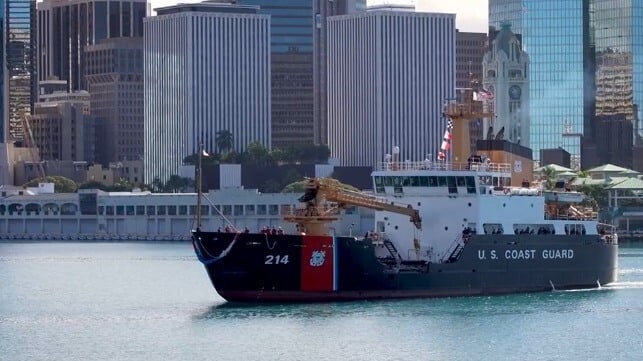US Coast Guard Finishes a 16-Ship Life Extension, On Time and Under Budget

The U.S. Coast Guard buoy tender USCGC Hollyhock is back in service and at work in the Pacific, where she will maintain the service's aids to navigation in Hawaii and in far-flung island territories. The vessel is the last of the 16 Juniper-class hulls to complete a midlife refit and life extension, and the class-wide overhaul program is now complete - on time and under budget, a rarity in a large-scale government shipyard project.
For Hollyhock, the 800-day-long refit included upgraded machinery control systems, propellers and HVAC, along with hull repairs and replacement of obsolete equipment. Reliability and uptime will be key in the vast distances of the Pacific: When deployed on foreign-assistance missions to help out with buoy servicing in remote island chains, Hollyhock will often be the only American presence of any kind. "Our arrival enhances the Coast Guard’s capacity to maintain vital navigational aids that facilitate the safe flow of maritime commerce. This is especially crucial in Hawaii, where more than 90% of goods arrive by sea," said Cmdr. Jessica McCollum, commanding officer of the Hollyhock.
The refit program for the Junipers evolved from previous efforts to overhaul and extend the life of the medium-endurance cutter fleet; that earlier program was successful enough that some of the oldest examples of the WMEC class are still on patrol today, after six decades in seagoing operation. The buoy tender refit program spanned a difficult era for shipyard work - a 10-year timeline from the mid-2010s, which included two government shutdowns, COVID-19, a Coast Guard recruiting crisis, shipyard labor shortages and the post-pandemic period of heightened inflation - but through it all, the series of overhauls stayed on track.
“This outstanding accomplishment highlights the Coast Guard’s commitment to delivering reliable, mission-ready vessels both efficiently and cost-effectively,” said Kenneth King, the program manager for midlife maintenance, in a statement upon redelivery. “Completing these 16 major maintenance availabilities on time and under budget exemplifies the service’s strategic approach to recapitalization, ensuring greater operational availability, reduced lifecycle costs and enhanced readiness to meet the Coast Guard’s critical missions.”
By contrast, U.S. Navy repair programs generally struggled with delays and budget overruns during the same period - exemplified by the four-year effort to repair the brand new USS Gerald R. Ford, the six-year midlife refit for USS George Washington, and the $1.8 billion spent on refitting cruisers that were then decommissioned. These vessel classes all have far higher level of technical complexity than Coast Guard assets, and driving down maintenance cost and duration is a top priority for the Navy.
